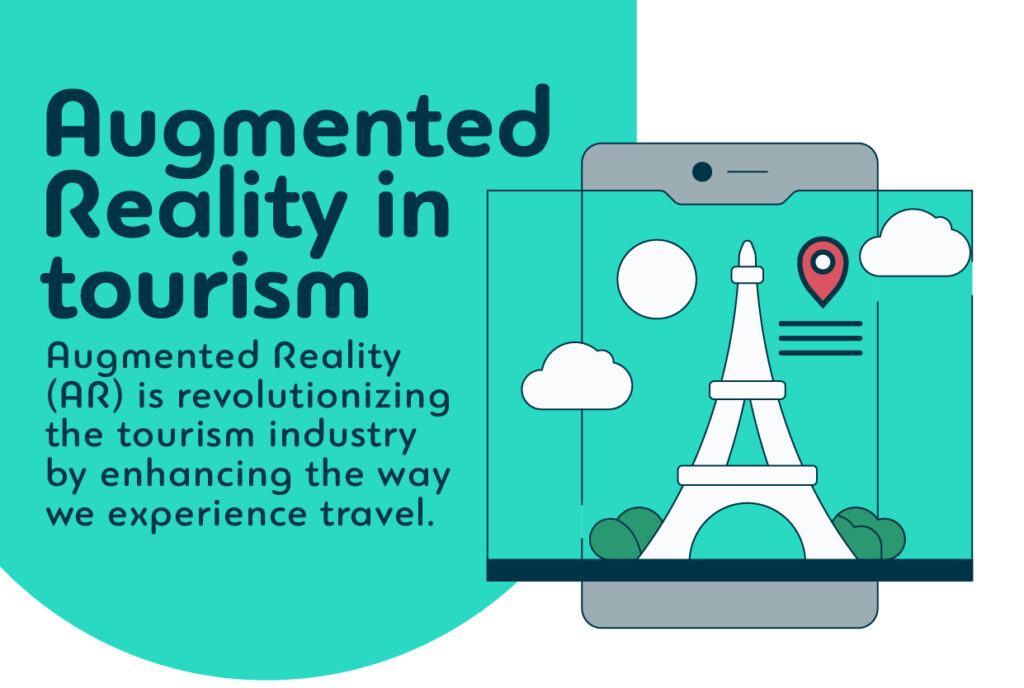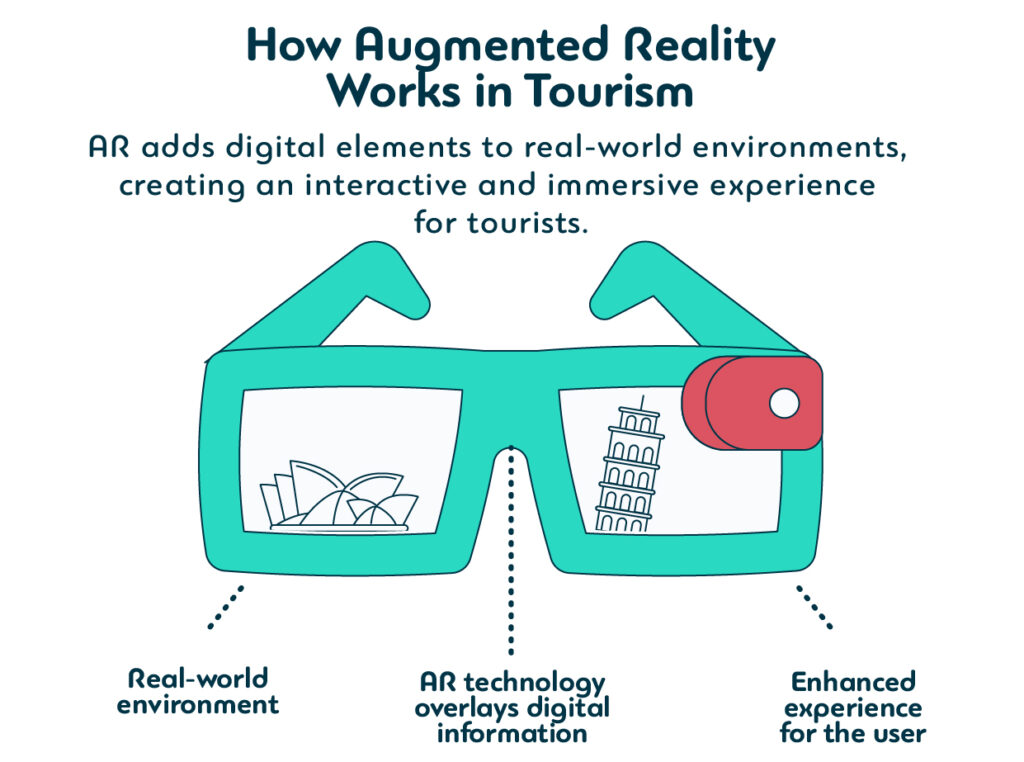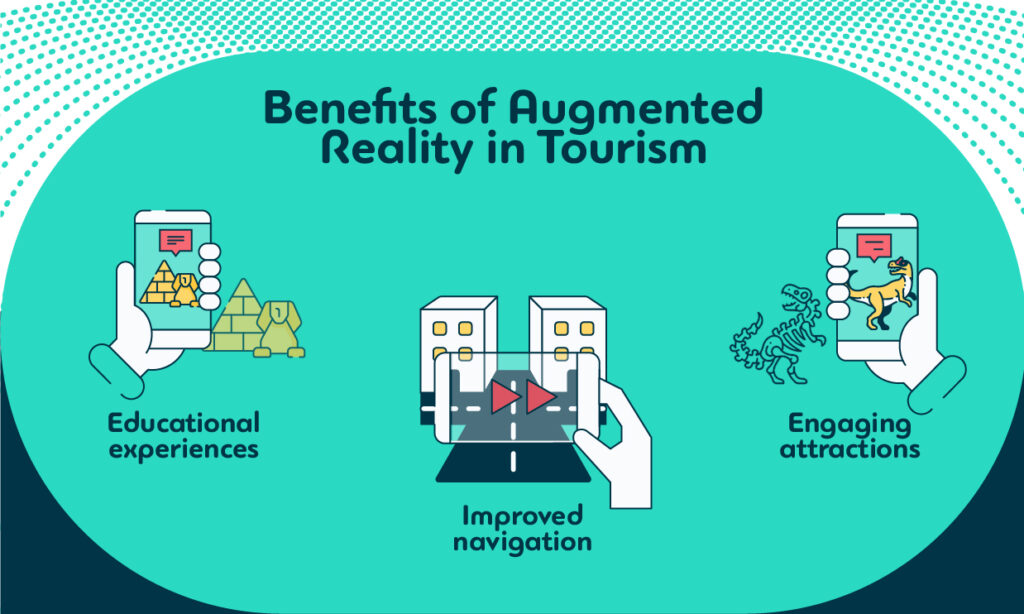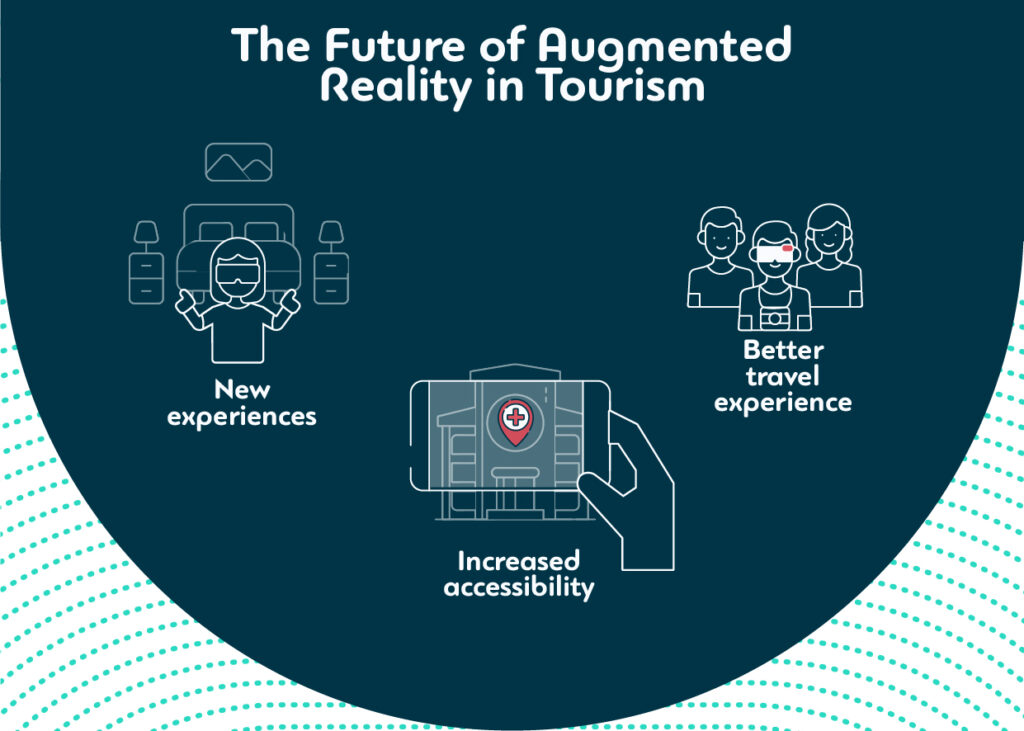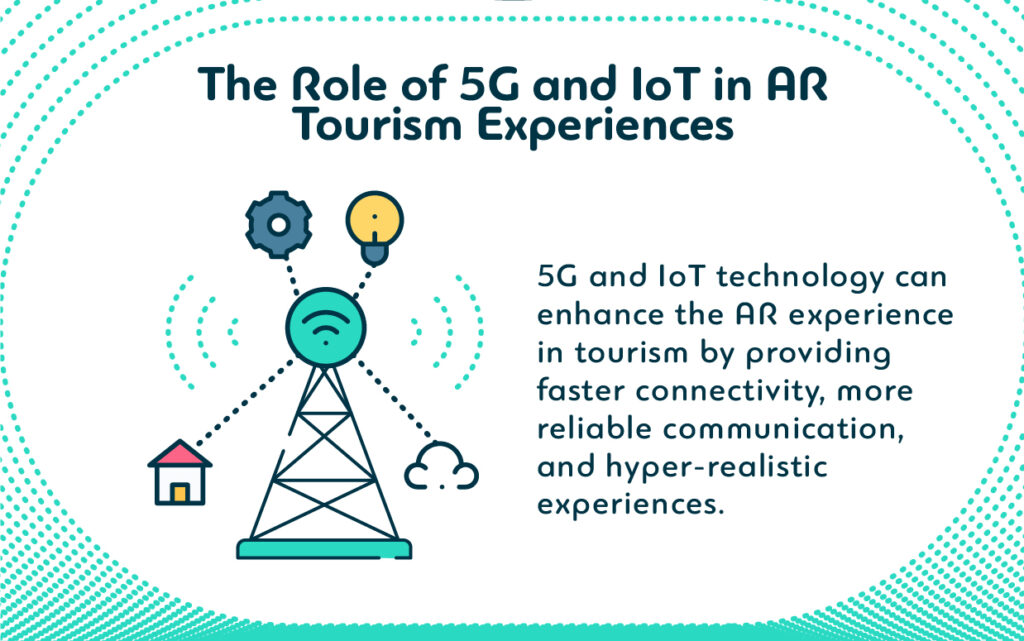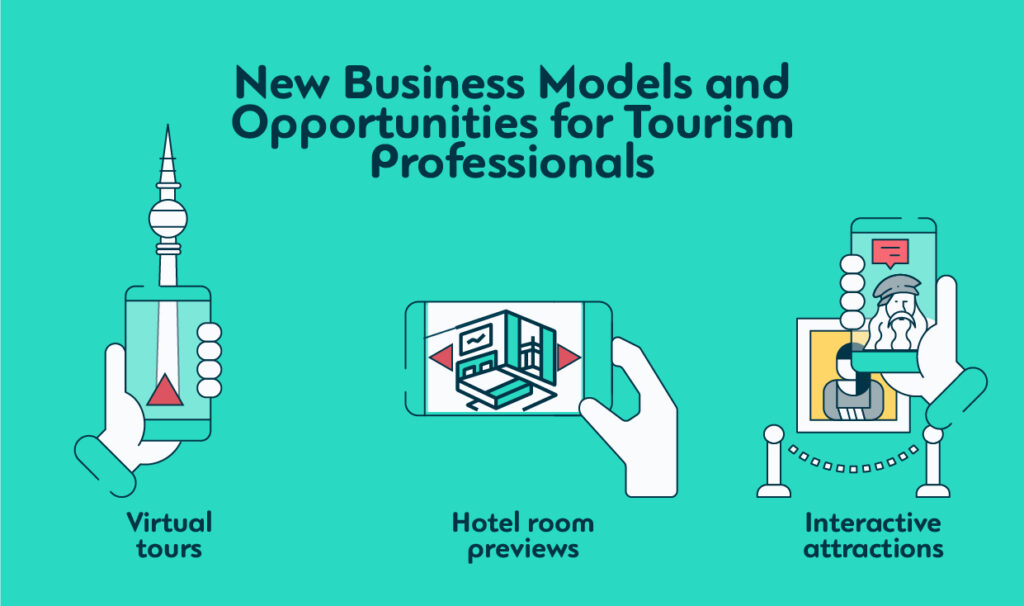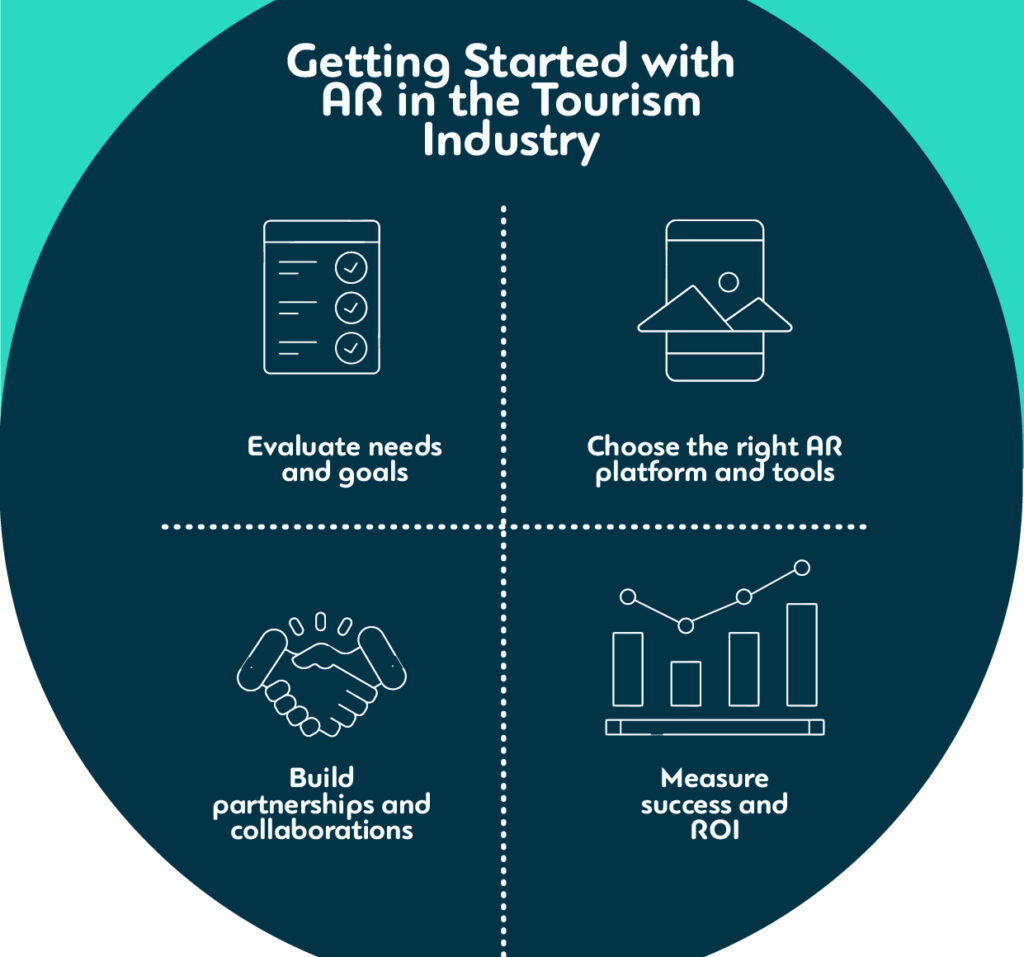5 Ways Augmented Reality is Enhancing the Tourism Experience

- What Is Augmented Reality AR?
- How is Augmented Reality Used in Tourism?
- The Benefits of AR for Tourism Industry Professionals
- Challenges and Limitations of Augmented Reality in Tourism
- Case Studies: Successful AR Implementations in Tourism
- Best Practices When Using Augmented Reality
- What is the Future of Augmented Reality in Tourism?
- How to Get Started with AR in the Tourism Industry
- Conclusion
- Frequently Asked Questions (FAQ)
Augmented reality (AR) can truly transform the way people discover and explore new places. By combining physical exploration with digital elements, travelers are able to gain deeper insights into different cultures while making memories along the way.
In today’s world, more and more travelers are turning to technology to add excitement and convenience to their trips. That’s why the hospitality and travel industry has explored ways to leverage innovative applications to empower travelers.
New tech offers tourists new experiences, and that’s precisely what augmented reality (AR) is doing. The new tourist wants to visit a destination and create a fully immersive, interactive, and unforgettable experience.
With a population of around 82 million, Gen Z makes up the majority of the U.S. consumer population and generation ready to travel that travel companies need to be targeting. Gen Z is tech-addicted and highly connected, making them a powerful target demographic for businesses to reach.
In this blog post, we’ll discuss what augmented reality is, its current use in the tourism industry, its benefits and challenges, as well as case studies and applications. We will also explore its potential future developments.
What Is Augmented Reality AR?
First off, let’s define what augmented reality is.
Simply put, augmented reality (AR) technology adds a digital layer to the physical world.
Users can scan an object, specific location, or image using a smartphone or an AR-enabled device to see additional information that is not visible to the naked eye. Visual and auditory elements such as graphics, text, animations, 3D models, videos, sound effects, and more can be combined to create an immersive experience.
For example, tourists can point their device at a historical monument and see its history or virtual models overlaid on the physical world, providing new perspectives on old landmarks.
Not to be confused with virtual reality (VR), which replaces the real world with a completely digital one, AR simply builds on the reality that is already there.
Mixed reality (MR) is an interactive experience combining aspects of both physical and virtual worlds. Users can realistically interact with virtual objects.
How is Augmented Reality Used in Tourism?
As stated by Meta, “AR and VR will add a new layer of presence to our lives, giving us the opportunity to connect in immersive, authentic ways, regardless of physical boundaries. And we’re already seeing signs that point to the desire—and need—for these new technologies.”
The possibilities of augmented reality in the travel industry are vast and open up a world of personalized, meaningful, engaging, educational experiences. Here are just a few of the ways in which augmented reality is currently being used to revolutionize tourism:
1. Navigation and Wayfinding
Travel brochures and physical books are becoming less popular. With technological advancements, information can now be shared through various means. One of those ways is AR.
Augmented reality can make an unknown city navigable. Tourists can access information about their destination and area while they explore through their smartphones. Travelers can use AR to find restaurants, bars, shops, transport, activities, and hotels making navigation in unfamiliar areas quicker, more convenient, and personalized.
Statistica estimates that the mobile AR market is expected to grow from $21 billion in 2023 to $36.2 billion by 2026.
Hotels can utilize AR or VR technology to provide guests with virtual tours of rooms and hotel amenities. That way, guests can easily navigate the hotel property and take advantage of the available amenities.
2. Interactive and Immersive Experiences
People like stories, and AR brings those stories to life, creating unforgettable experiences by enhancing and complementing the natural beauty of a place. AR technology in tourism allows visitors to immerse themselves in new experiences, transforming them from passive observers to active participants.
The 2023 Global Travel Trends Report from American Express Travel states that “Travelers want authentic experiences that give them a taste of local culture and let them explore hidden gems that friends back home don’t know about.”
The interconnectedness between a place and technology enhances a traveler’s experience and allows them to experience the extraordinary. Augmented reality gives travelers a front-row seat to these new experiences by making places more interactive, immersive, and meaningful.
3. Museums and Cultural Heritage Sites
One of the biggest benefits of AR is how it can enhance the educational value of tourism. Instead of reading plaques and passively listening to audio guides, tourists can use AR to interact directly with their environment.
AR-powered apps can help museums create AR experiences and tours that act as their own personal tour guide. This represents both the future of tours and a departure from traditional organized tours.
Travelers can now interact with and fully immerse themselves in the environment. This includes recreating authentic places and simulating historical events to take you back in time through a 360-degree experience.
Imagine being able to see how the Colosseum in Rome looked in its prime or how the ancient city of Pompeii looked before the eruption of Mount Vesuvius. With AR, tourists can experience history like never before and better understand a location’s culture and heritage.
4. Language Translation and Communication
AR technology bridges language barriers, making communication easier for tourists and locals. Visitors can use AR apps to translate signs and menus, enabling them to interact with locals in their own language or even eliminating the need to stop and ask for directions.
By combining augmented reality with image recognition and voice commands, travelers can communicate more freely with locals.
5. Personalized Recommendations and Trip Planning
Many travelers conduct extensive research before and during their trip, and AR technology makes it easy for them to access the right information at the right time and in the right place.
AR apps can provide travelers with tailored experiences and information based on their needs and preferences. For example, they can offer personalized recommendations on what to do or where to eat near the traveler’s location. These tailored experiences can often be accessed through beacon technology, which we will discuss later.
The Benefits of AR for Tourism Industry Professionals
Tourism industry professionals can significantly benefit by using augmented reality as it can be a valuable tool for increasing customer satisfaction, average order value, and the bottom line.
1. Enhanced Visitor Engagement
Businesses in the travel industry can use augmented reality to enhance their existing selling points and offer customers a glimpse of the experience or destination they are promoting.
According to Threekit, “AR product experiences are 200% more engaging as they deliver double the levels of engagement compared to their non AR equivalent.”
By giving visitors a personalized, immersive experience, businesses can better engage and inspire them to take action. For example, a museum could enhance visits by providing a tour highlighting exciting facts or information about the exhibit as visitors move through the museum.
2. Increased Revenue Opportunities
A unique experience can trigger users to book the trip or experience and choose you over the competition. Travelers already want to go to a specific location, but they are looking for a unique experience that augmented reality can bring.
Snapchat found, “For Travel, Snapchatters expect to spend more than they typically would when AR is a part of their travel planning journey. This is because AR helps them be more confident in making decisions about the trip and ultimately planning longer trips by adding travel excursions or other add-ons to the itinerary.”
3. Better Customer Insights and Data Collection
Augmented reality helps gather helpful information on how customers engage with their surroundings and what services or experiences they prefer. Knowing where customers spend the most time or what they are looking for can help tailor their experiences and make them more memorable.
Understanding the important role of technology in tourism can provide better customer insights and data to inform the implementation of augmented reality. It can also help organizations identify patterns, make decisions faster, and improve the customer experience.
4. Improved Destination Marketing
Destination marketing has been vastly improved over the years. One of the best ways to draw in travelers during their trip-planning process is through immersive experiences.
For example, hotels can create an immersive experience and transport travelers to their destinations through their smartphones. Travelers can experience what it would be like to be in their hotel room, eating at your restaurant, or sitting at the pool.
Challenges and Limitations of Augmented Reality in Tourism
While AR has many benefits, it is still a highly advanced technology. Specific challenges must be addressed before they can become mainstream. Let’s take a look at the most common ones.
1. Technological Barriers and Infrastructure Requirements
The major players in augmented reality are facing difficulties in delivering satisfactory products to their customers. Google Glass was released to the market in 2013 but failed to make a lasting impact. By March of 2023, Google had stopped selling the Glass Enterprise Edition. The main reason for this failure was its high price tag. Mark Zuckerberg is developing AR glasses which are expected to launch in 2024 but may take longer to roll out.
The biggest barrier to making augmented reality well a reality is technological limitations. Specifically within the travel industry, using augmented reality apps in travel locations with weak network coverage can be difficult, fragmenting the user’s experience.
Research conducted by the International Journal of Engineering Business Management states, “Mobile devices will need to have fast CPU, large RAM capacity, a camera and Wi‐Fi or 3G enabled Internet connection which will allow data transmission.” With that being said, almost all smartphones are equipped to support mobile AR applications.
Even though accessing AR technology through smartphones is easy for users, hardware limitations exist, such as processing power, limited battery life, and small phone screens. To produce compelling and quality augmented reality content, one needs specific expertise and equipment. Therefore, weighing the cost against the potential gains is advisable.
2. Privacy and Data Security Concerns
When booking flights, hotels, or other travel services, tourists may need to share personal information like their name, address, and credit card information. Unfortunately, others could use this information maliciously, leading to fraud and identity theft.
Google’s glasses recorded videos and took pictures without people’s knowledge or consent, leading to significant concerns regarding privacy and data security. In large part, augmented reality is accessed through people’s smartphone cameras, so it is important to clearly understand how this data will be used and who will have access.
Third-party cookies are bits of code that are added to websites to monitor user activity. This monitoring can infringe on users’ privacy rights if not explicitly stated. To address this, tourism businesses must ensure they have clear guidelines to protect user data. Some regions have imposed regulations like GDPR that restrict the use of third-party cookies.
Tourism apps and services often use location tracking for customized recommendations and travel advice. This can improve the travel experience but also raises privacy concerns.
3. Balancing authenticity and digital enhancement
Using AR technology during travel can have both positive and negative effects. While it can enhance the overall experience, excessive use may reduce the authenticity of the destination.
Augmented reality is meant to enhance, not replace, the physical location. Travelers travel to a destination to experience it for themselves. Instead of replacing the experience, AR should be used to empower travelers with real-time information and insights about their experiences. It should also provide them with the ability to explore and discover new things on their own.
4. Environmental and Social Impacts
To use AR technology responsibly and ethically, evaluating its potential impact on a location’s environment and social aspects is important. Governments and organizations must establish guidelines to safeguard tourist destinations as technology advances.
Case Studies: Successful AR Implementations in Tourism
The most notable AR application that has been adopted by many users is Pokemon Go, an interactive game designed to get users out to explore different locations within a city. Let’s explore the various implementations in tourism.
Google Maps and Translate
Google Maps allows users to explore a new location virtually while traveling or before visiting. They are continuing to improve their augmented reality capabilities. Soon users will be able to point their phone at a restaurant or hotel and see its reviews.
Travelers can use AR to better understand foreign languages. Google Translate allows users to translate signs and menus by pointing their smartphone camera at the object they want to translate.
The Metaverse
Meta has made significant investments in the development of the metaverse. They have demonstrated the power of augmented reality in action by allowing users to virtually be placed inside a shark cage in South Africa. Users can scan a QR code on their website to take them to the Facebook app.
AR Tour Guides
For example, the Colosseum in Rome has a self-guided tour with augmented reality on the Colosseum & Roman Forum. In Paris, you can tour the city with an AR tablet.
Beacon Technology
Beacon technology is small Bluetooth devices called beacons that transmit a unique signal between a nearby device and a specific location.
When a smartphone or AR-enabled device picks up a signal, it can use AR technology to display an overlay in the real world. This was the case with Pokemon Go.
Best Practices When Using Augmented Reality
Target the Right Audience
To make your AR application more effective, you should determine which users would benefit most and customize it to meet their specific needs. Doing so will ensure that the application resonates with users, leading to higher engagement and a greater return on your investment.
Keep it Simple
Make sure that the user interface is intuitive and easy to use, with minimal steps necessary for completing tasks. The more complex the interface, the less likely users interact with your application.
Invest in Quality Content
Ensure that the visuals, audio, and text used are high quality to ensure a positive user experience. Low-quality content can lead to a lack of adoption and impede the user’s ability to interact with your application.
What is the Future of Augmented Reality in Tourism?
The tourism industry is on the cusp of significant innovation and technological advancements powered by augmented reality (AR) and virtual reality (VR).
Predictions for AR Technology Advancements in Tourism
Augmented reality allows travelers to experience a destination more realistically and interactively before they even step foot in it.
New Experiences
It has the potential to unlock a wide range of new experiences for travelers. For example, you can enable customers to tour hotels, attractions, and restaurants virtually. You can also create virtual tours of cities, allowing travelers to explore even more of the destination they are visiting.
Increased Accessibility
In addition, as augmented reality becomes more accessible through smartphones and AR-enable devices, tourism organizations can use this technology to visually represent their destinations and encourage transactions.
Better Travel Experience
AR will increasingly be used to improve the overall travel experience by providing interactive and personalized tours, activities, and transportation. This means that tourists will have access to comprehensive information and multimedia content about their environment, allowing them to have a deeper understanding of their chosen destination.
An article by the School of Hospitality, Food, and Tourism Management stated that “By encouraging tourists use AR, destinations could utilize this technology to enhance tourists’ experience during different stages of a trip, i.e. pre-travel stage: trip planning information and guidance, during travel stage: on-site experience, and post-travel stage: satisfaction information.”
The Role of 5G and IoT in AR Tourism Experiences
Using a network of connected devices and sensors, the combination of 5G and IoT technology can potentially enhance the AR experience in tourism.
5G networks offer faster and more reliable connectivity due to increased bandwidth and lower latency; the AR experience can be smoother and more responsive.
The IoT enables multiple devices to communicate with each other and connect to the internet quickly and reliably. For example, When a tourist visits a specific area of a museum, beacon technology can trigger the display of relevant information.
This combination of technology helps to create hyper-realistic augmented reality experiences for tourists.
The Integration of AR with Virtual Reality (VR) and Mixed Reality (MR)
As we defined earlier, the integration of augmented, virtual, and mixed reality combines these different technologies to create an enhanced experience tailored and personalized for the user.
For example:
- Augmented reality can enhance an experience or destination by adding interactive elements or contextual information to the environment
- Virtual reality can transport the user into an entirely new reality
- Mixed reality takes virtual and augmented reality and combines them into a single unified experience
Depending on the user’s needs and the intended application, different combinations of these technologies can create an immersive experience.
New Business Models and Opportunities for Tourism Professionals
As augmented reality and other related technologies become more accessible, the industry will inevitably have to adjust its business models.
The introduction of these technologies opens up the possibility of new services and opportunities, such as virtual tours, hotel room previews, and interactive attractions.
Tourism professionals can also use this technology to provide an enhanced customer experience by personalizing content for each individual needs.
In addition, they can use this technology to collect data and insights about user behavior, allowing them to use these insights to create new business models and jump on new opportunities.
How to Get Started with AR in the Tourism Industry
1. Evaluating the Needs and Goals of Your Business
Figuring out what the business needs to accomplish with an AR experience is the first step in getting started with AR. Assess how adopting AR technology could help you achieve your business goals. Whether it be increasing customer engagement or furthering the brand’s reach. Then you can brainstorm potential ways to incorporate AR into your existing offerings.
2. Choosing the Right AR Platform and Tools
The second step is identifying the right platforms and tools that you’ll need to create the AR experience you envision. Do your research and consider the goals of your project when selecting a platform.
You will likely outsource this project to a qualified AR development company. To find the right team, look for one with experience creating custom experiences for businesses like yours.
3. Building Partnerships and Collaborations
Collaborating with other tourism industry professionals and local vendors to develop innovative AR-based experiences. For example, teaming up with a hotel chain to create an immersive virtual tour of their property or working with a travel agency to build an interactive map of the region.
4. Measuring Success and ROI
Use analytics and data to measure the success of your AR-based tourism experience and its impact on customer engagement. This includes tracking user engagement, conversion rates, and other key performance indicators.
Conclusion
In conclusion, augmented reality is changing the way we experience tourism. From enhancing education to creating unique experiences, AR adds excitement to exploring historical and cultural locations.
Destinations, travel agencies, and tour operators can embrace AR technology to create a more personal experience for tourists, enhancing customer experiences while catering to their constantly evolving needs and desires.
As advancements in AR technology continue to progress, we can only expect new ways for tourists to interact with their surroundings. It’s safe to say that we are heading towards a more immersive and fulfilling tourism experience.
Frequently Asked Questions (FAQ)
Augmented reality is a relatively new technology that can bring products, services, and offerings to life like never before. Small businesses can stand out from the crowd by creating one-of-a-kind immersive experiences for their target audience. This level of customization helps engage customers and draw them deeper into the brand and products they offer.
The costs associated with implementing AR in tourism depend on the project’s complexity, the type of content used, and any additional features or services wanted. For example, a hotel room tour might require 3D modeling. In contrast, an AR tour may require software development to create interactive 3D visuals. To maximize their AR experience, businesses should research their specific needs and allocate their budget accordingly.
For a successful experience, it’s important to make AR experiences accessible to all visitors. This can be achieved by businesses taking into account the needs of all users, considering factors such as visual and auditory impairments, cultural considerations, language barriers, and any other accessibility issues. To create an engaging and accessible AR experience for all visitors, businesses should offer clear instructions and ensure the content is easy to consume.
The use of AR can assist in promoting sustainable and responsible tourism by offering visitors an enjoyable and informative experience.
Through interactive AR programs, businesses can offer insights into a destination’s culture, environment, and history. Companies can tap into the uniqueness of a location and provide immersive learning experiences to educate visitors on sustainable and responsible practices.
AR can also be used to present the potential environmental, social, and economic impacts of certain decisions, inspiring visitors to be more conscious of their actions while traveling.
Businesses should consider legal and ethical considerations when incorporating AR in tourism. It is crucial to obtain necessary licenses or permissions for the content or technology used in the AR experience to ensure compliance with the law. In addition, it’s beneficial to consult a lawyer about possible copyright or trademark conflicts when creating an AR experience.
Subscribe to
our newsletter
Yay! You are now
subscribed to our
newsletter
Mize is the leading hotel booking optimization solution in the world. With over 170 partners using our fintech products, Mize creates new extra profit for the hotel booking industry using its fully automated proprietary technology and has generated hundreds of millions of dollars in revenue across its suite of products for its partners. Mize was founded in 2016 with its headquarters in Tel Aviv and offices worldwide.
Related Posts
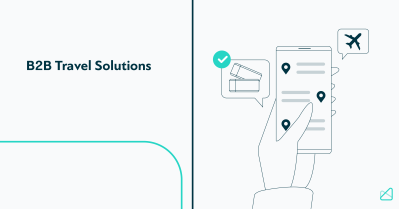
Your Ultimate Guide to B2B Travel Solutions
17 min. You’ve probably noticed that B2B travel solutions play a vital role in the global B2B travel sector. We are talking about the market bound to reach the size of $4952.96 by 2028. That’s a CAGR Growth of 17.51%. No wonder leading B2B travel solutions process over 80.000 bookings and 14.000 searches a day. […]
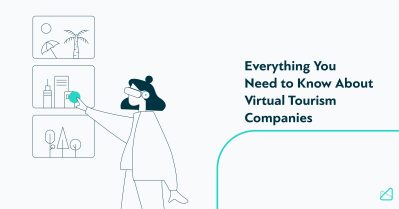
Everything You Need to Know About Virtual Tourism Companies
24 min. Virtual tourism refers to a specific tourism niche using technology that enables travelers to experience activities, locations, and destinations without leaving their homes. The types of virtual tours depend on the multimedia format offered to travelers. It can be anything ranging from still images, video, and audio to interactive virtual reality. The popularity […]

Unlocking the Potential of Blockchain Technology in Travel
11 min. Blockchain technology has opened up the potential to revolutionize the travel and tourism industry, allowing businesses and travelers alike to benefit from the safety, security, and efficiency that Blockchain provides. According to Informatics research, “In 2025, blockchain technology is expected to become a central component of business operations in the hospitality and tourism […]
